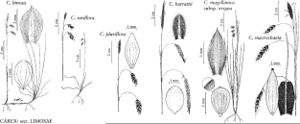Carex macrochaeta
Mém. Acad. Imp. Sci. St.-Pétersbourg Divers Savans 1: 224. 1831.
Culms aphyllopodic, without dead leaf remains at base, 20–70 cm. Leaf-blades 2–5 mm wide, margins revolute, scabrous at tip. Inflorescences: proximal bracts 4–11 cm, shorter to longer than inflorescences; lateral spikes 10–30 × 6–8 mm, with 15–40 perigynia; terminal spikes 12–32 × 3–8 mm. Pistillate scales lanceolate, 3–7.5 (–9) × 1.6–2.5 mm, narrower that, longer than perigynia, awn to 2–12 mm. Staminate scales oblong-obovate, 4.5–6 × 1.3–2.4 mm, apex bifid to emarginate, at least proximal scales with awn 2–6 mm. Anthers 3.3–5 mm. Perigynia 3.8–6.8 × 1.7–2.3 mm, apex tapering and rounded; beak 0.1–0.3 mm. 2n = 60.
Phenology: Fruiting summer.
Habitat: Marshes, shores, and other wet open places
Elevation: 0–1000 m
Distribution

B.C., Yukon, Alaska, Oreg., Wash., coastal Asia
Discussion
T. V. Egorova (1999) included Carex macrochaeta in sect. Scitae. The species commonly has a white or cream tomentum on many roots, although most individuals have at least some roots with a yellowish tomentum. The sectional placement of this species requires further investigation.
Selected References
None.
Lower Taxa
"shortened" is not a number.
